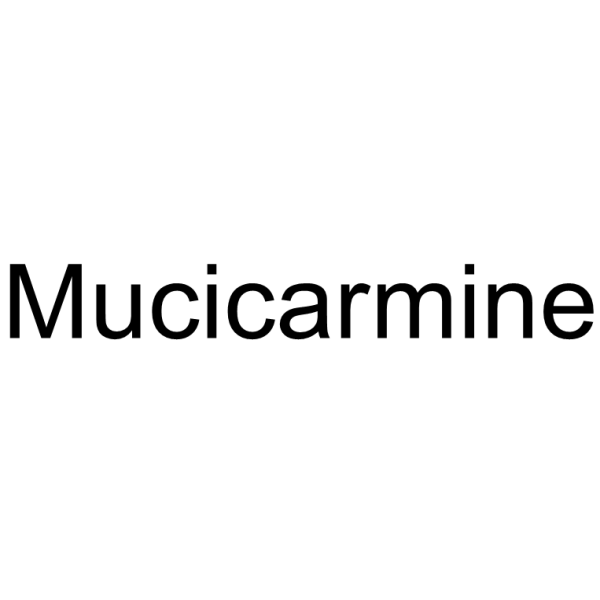Mucicarmine

Mucicarmine structure
|
Common Name | Mucicarmine | ||
|---|---|---|---|---|
| CAS Number | 51395-97-2 | Molecular Weight | N/A | |
| Density | N/A | Boiling Point | N/A | |
| Molecular Formula | N/A | Melting Point | N/A | |
| MSDS | USA | Flash Point | N/A | |
| Symbol |


GHS05, GHS08 |
Signal Word | Danger | |
Use of MucicarmineMucicarmine is used in the histological visualization of acid mucopolysaccharides in tissue sections. Mucicarmine can identify mucin (deep rose), which is useful in determining the mucin positive cancer (such as liver carcinoma)[1]. |
| Name | Mucicarmine |
|---|---|
| Synonym | More Synonyms |
| Description | Mucicarmine is used in the histological visualization of acid mucopolysaccharides in tissue sections. Mucicarmine can identify mucin (deep rose), which is useful in determining the mucin positive cancer (such as liver carcinoma)[1]. |
|---|---|
| Related Catalog | |
| Target |
Mucin[1] |
| In Vitro | Mucicarmine successfully stains the presence of mucin on frozen-tissue sections (Mucin stained deep rose). Guidelines (Following is our recommended protocol. This protocol only provides a guideline, and should be modified according to your specific needs)[1]. 1. Mount the cryostat sections (thickness: 4 to 5 μm) onto coated glass slides. 2. Fix the sections in frozen-section fixative immediately for 30 seconds and then rinse with water for 5 seconds. 3. Immerse the glass slides for 30 seconds into Harris hematoxylin, then consecutively into distilled water, ammonium hydroxide, and distilled water, for 5 seconds in each solution. 4. The mucicarmine stain is placed in the microwave oven and microwave until the solution is about to bubble (30 seconds). 5. Immerse the glass slides in the warmed mucicarmine solution for 2 minutes and rinse slides in distilled water for 5 seconds. 7. Immerse the glass slides consecutively in 95% alcohol, 100% alcohol, and xylene for 5 seconds in each solution, then coverslip the slides. Note: Nuclei stain (blue) and connective tissue stain (green) maybe is necessary according to your specific needs. |
| References |
| No Any Chemical & Physical Properties |
| Symbol |


GHS05, GHS08 |
|---|---|
| Signal Word | Danger |
| Hazard Statements | H314-H372 |
| Precautionary Statements | P280-P303 + P361 + P353-P304 + P340 + P310-P305 + P351 + P338-P314 |
| Personal Protective Equipment | Faceshields;full-face respirator (US);Gloves;Goggles;multi-purpose combination respirator cartridge (US);type ABEK (EN14387) respirator filter |
| RIDADR | UN 2581 8 / PGIII |
|
De-staining and re-staining mucins in formalin fixed paraffin sections.
Biotech. Histochem. 86(2) , 98-103, (2011) Re-staining of formalin fixed paraffin sections sometimes is required and this requires prior de-staining. Some simple and effective protocols for de-staining are described. Mucihematoxylin and mucica... |
|
|
Amphicrine carcinoma of the liver.
Ann. Diagn. Pathol. 15(5) , 355-7, (2011) Amphicrine tumors are defined by evidence of both glandular and neuroendocrine differentiation in the same cell. These are extremely rare tumors, with only scattered case reports in the pancreas and s... |
|
|
Anti-human milk fat globulin staining of perifollicular xanthomatosis in Fox-Fordyce disease.
J. Cutan. Pathol. 39(12) , 1057-9, (2012)
|
| MFCD00071289 |